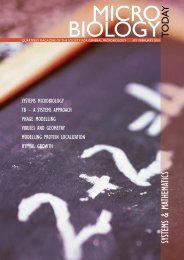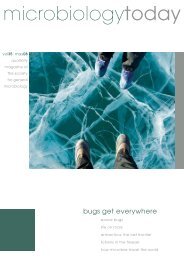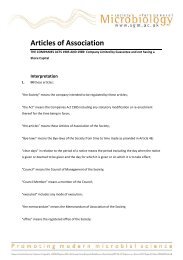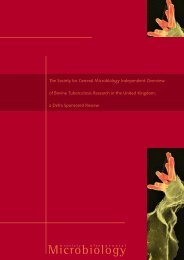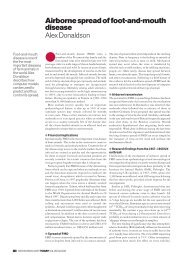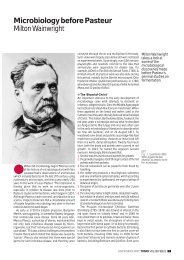Download - Society for General Microbiology
Download - Society for General Microbiology
Download - Society for General Microbiology
You also want an ePaper? Increase the reach of your titles
YUMPU automatically turns print PDFs into web optimized ePapers that Google loves.
Bacterial<br />
sequences in<br />
an invertebrate<br />
genome<br />
The genomes of<br />
many nematodes<br />
and arthropods<br />
contain bacterial<br />
sequences. How did<br />
they get there? Julie<br />
C. Dunning Hotopp<br />
and Jason Rasgon<br />
explain.<br />
m Wolbachia infect the most abundant animal<br />
phyla including nematodes and arthropods.<br />
This includes some bees and butterflies like<br />
those shown here. J.C. Dunning Hotopp<br />
Wolbachia pipientis is the most prolific<br />
intracellular endosymbiont on earth.<br />
These bacteria infect not only 70% of<br />
insects, but also the most abundant<br />
animal phyla, including nematodes and<br />
arthropods.<br />
The arthropod-infecting Wolbachia exert unusual effects on<br />
host reproduction, including: (1) parthenogenesis, whereby<br />
infected virgin females produce infected female offspring,<br />
(2) male killing, whereby infected male embryos fail to<br />
develop, (3) feminization, whereby genetic males develop<br />
into reproductively capable females, and (4) cytoplasmic<br />
incompatibility, the most common phenotype, whereby the<br />
offspring of uninfected females and infected males fail to<br />
develop. Wolbachia are maternally inherited, being transferred<br />
through the egg cytoplasm. There<strong>for</strong>e, these reproductive<br />
phenotypes favouring Wolbachia-infected females increase<br />
the proliferation of Wolbachia-infected arthropods. Wolbachia<br />
are parasitic endosymbionts, since the interaction benefits<br />
Wolbachia while exerting a negative effect on the host by<br />
limiting genetic exchange. However, a mutualistic role<br />
benefiting both organisms cannot be excluded.<br />
Unlike infections in arthropods,<br />
treatment of nematodes with antibiotics<br />
that are targeted at eliminating<br />
the Wolbachia infection also<br />
kills the host. This suggests that Wolbachia<br />
<strong>for</strong>m an obligate mutualistic<br />
symbiosis with filarial nematodes,<br />
since neither organism can survive<br />
without the other. The exact nature<br />
of the mutualistic interaction is not<br />
known, but it has been proposed<br />
that Wolbachia provide the host with<br />
necessary nucleotides, cofactors and<br />
vitamins.<br />
Despite maternal inheritance in<br />
arthropods, arthropod-borne Wolbachia<br />
do not evolve with the host. Instead, the<br />
bacteria are transmitted horizontally<br />
and infections are lost, although the<br />
mechanisms are not understood. In<br />
contrast, filarial nematodes and<br />
Wolbachia evolve together, reflecting<br />
the obligate symbioses between these<br />
bacteria and their hosts.<br />
Interdomain lateral gene<br />
transfer<br />
In 2001, Natsuko Kondo and<br />
colleagues described a variant of a<br />
bean beetle, Callosobruchus chinensis,<br />
where Wolbachia genes had moved<br />
into the insect chromosome. This<br />
movement of DNA from an organism<br />
176 microbiology today nov 08 microbiology today nov 08 177



